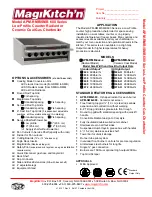
91
X. Operation
G. Changing Adjustable Parameters (continued)
“Press”
Central
Heat
button to access the following parameters:
Factory
Setting Range / Choices
Parameter and Description
180°F
(82.2°C)
80°F to 190°F
(26.7°C to 87.8°C)
Central Heat Setpoint
Target temperature for the central heat priority. Value also used by the outdoor air reset function.
170°F
(76.7°C)
80°F to 190°F
(26.7°C to 87.8°C)
Central Heat Thermostat “Sleep” or “Away” Setback Setpoint
Thermostat setback setpoint is used when the EnviraCOM thermostat is in “leave” or “sleep”
modes and sensed at E-COM terminals D, R, and C. When setback is “on” the thermostat set
-
back setpoint shifts the reset curve to save energy while home is in a reduced room temperature
mode. The reset curve is shifted by the difference between the High Boiler Water Temperature
and the Thermostat Setback Setpoint. Honeywell VisionPro IAQ part number TH9421C1004 is a
“setback” EnviraCOM enabled thermostat. When connected, it allows boiler water setback cost
savings.
5°F
(2.8°C)
2°F to 10°F
(1.1°C to 5.6°C)
Central Heat Diff Above
The boiler stops when the water temperature rises ‘Diff Above’ degrees above the setpoint.
7°F
(3.9°C)
2°F to 30°F
(1.1°C to 17°C)
Central Heat Diff Below
The boiler starts when the water temperature drops ‘Diff Below’ degrees below the setpoint.
3
1 to 5
Response Speed
This parameter adjusts the Central Heat temperature controller Proportion Integral Derivative
(PID) values. Higher values cause a larger firing rate change for each degree of temperature
change. If set too high firing rate “overshoots” required value, increases to high fire causing the
temperature to exceed the “Diff Above” setpoint and cycle the boiler unnecessarily. Lower values
cause a smaller firing rate change for each degree of temperature change. If set too low, the
firing rate response will be sluggish and temperature will wander away from setpoint.
“Press”
Domestic
Hot Water
button to access the following parameters:
Factory
Setting Range / Choices
Parameter and Description
170°F
(76.7°C)
80°F to 190°F
(26.7°C to 87.8°C)
Domestic Hot Water Setpoint
The Domestic Hot Water (DHW) Setpoint parameter is used to create a minimum boiler water
temperature setpoint that is used when DHW heat demand is “on”.
When the DHW heat demand is not “on” (the contact is open or
not wired
) this setpoint is ignored.
160°F
(71.1°C)
80°F to 190°F
(26.7°C to 87.8°C)
Domestic Hot Water Thermostat “Sleep” or “Away” Setback Setpoint
Thermostat setback setpoint is used when the EnviraCOM thermostat is in “leave” or “sleep”
modes and sensed at E-COM terminals D, R, and C. When setback is “on” the thermostat set
-
back setpoint shifts the DHW setpoint to lower the DHW temperature and to save energy while
home is in a reduced room temperature mode.
5°F
(2.8°C)
2°F to 10°F
(1.1°C to 5.6°C)
Domestic Hot Water Diff Above
The boiler stops when the water temperature rises ‘Diff Above’ degrees above the setpoint.
7°F
(3.9°C)
2°F to 30°F
(1.1°C to 17°C)
Domestic Hot Water Diff Below
The boiler starts when the water temperature drops ‘Diff Below’ degrees below the setpoint.
Enable
Enable Disable
Domestic Hot Water Priority (DHWP)
When Domestic Hot Water Priority is Enabled and Domestic Hot Water (DHW) heat demand is
“on” the DHW demand will take “Priority” over home heating demand. When the System and
Boiler pumps are configured as “Central Heat (off DHW priority)” or “Central Heat, Optional
Priority” then they will be forced “off” during DHW Priority. Priority protection time is provided to
end DHWP in the event of a failed or excessive long DHW demand.
60
Minutes 30 to 120 Minutes
Priority Time
When DHWP is Enabled the Priority Time Parameter appears and is adjustable.
3
1 to 5
Response Speed
This parameter adjusts the Domestic Hot Water temperature controller Proportion Integral
Derivative (PID) values. Higher values cause a larger firing rate change for each degree of
temperature change. If set too high firing rate “overshoots” required value, increases to high fire
causing the temperature to exceed the “Diff Above” setpoint and cycle the boiler unnecessarily.
Lower values cause a smaller firing rate change for each degree of temperature change. If set
too low, the firing rate response will be sluggish and temperature will wander away from setpoint.
Summary of Contents for APEX
Page 57: ...57 VIII Electrical continued Figure 26 Ladder Diagram ...
Page 58: ...58 VIII Electrical continued ...
Page 59: ...59 Figure 27 Wiring Connections Diagram VIII Electrical continued ...
Page 105: ...105 ...
Page 109: ...109 XIII Repair Parts continued APX625 APX725 and APX825 APX825 shown ...
Page 112: ...112 XIII Repair Parts continued APX425 and APX525 ...
Page 114: ...114 XIII Repair Parts continued APX625 APX725 and APX825 ...
Page 122: ...122 ...
Page 123: ...123 ...
















































